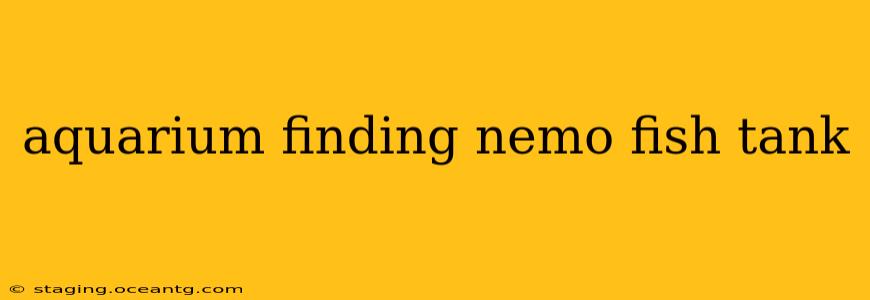Finding Nemo captivated audiences worldwide, igniting a passion for clownfish, particularly the ocellaris clownfish (also known as percula clownfish), Nemo himself. If you're inspired to create a Finding Nemo-themed aquarium, you've come to the right place. This guide will walk you through setting up a thriving and beautiful tank for your clownfish, covering everything from tank size to essential accessories.
What Size Tank Do I Need for Nemo Fish?
A common question among aspiring clownfish keepers is tank size. While a single clownfish could theoretically live in a smaller tank, ethical and responsible fish keeping dictates providing ample space for your fish to thrive. For a pair of ocellaris clownfish, a minimum of 20 gallons is recommended. Larger is always better! A 30-gallon tank or even larger provides more space for swimming, exploring, and overall well-being. Remember, a bigger tank is more stable and easier to maintain.
What are the essential items for a Finding Nemo fish tank?
Creating a realistic and healthy Finding Nemo environment requires careful planning. Here's a checklist of essential items:
- Aquarium: As mentioned, a 20-gallon tank (minimum) is a good starting point for a pair of clownfish.
- Filtration: A reliable filtration system is crucial. Choose an appropriately sized filter for your tank's volume, capable of handling the bioload of your fish and any other inhabitants.
- Heater: Clownfish require a consistent water temperature between 72-78°F (22-26°C). An accurate and reliable submersible heater is essential.
- Substrate: Live sand is preferred as it helps establish beneficial bacteria for biological filtration. Aragonite sand is a popular choice.
- Live Rock: Live rock provides hiding places, creates water flow, and supports beneficial bacteria. Aim for at least 1-2 pounds per gallon.
- Lighting: Clownfish appreciate moderate to bright lighting. LEDs are a popular and energy-efficient option.
- Water Test Kit: Regularly monitoring water parameters is crucial for maintaining a healthy environment. Invest in a reliable test kit for ammonia, nitrite, nitrate, and pH levels.
What kind of decorations should I use to make it look like Finding Nemo?
Transforming your aquarium into a Finding Nemo-inspired paradise involves thoughtful decoration. While you won't recreate the entire ocean, you can create a captivating habitat:
- Anemones: Clownfish naturally live in symbiosis with anemones. However, choosing the right anemone is crucial; consider a Maxi-Mini carpet anemone, which is relatively hardy. Thorough research and proper acclimation are essential before introducing any anemone to your tank.
- Live Coral (optional): Adding some hardy corals, like Zoanthids or mushrooms, can add beauty and complexity to the environment. Beginners should proceed with caution and only add corals after the tank has fully cycled and water parameters are stable.
- Realistic Decorations: Incorporate artificial plants, rocks, and caves to mimic Nemo's natural habitat. Avoid sharp decorations that could injure your fish.
What other fish can I keep with Nemo?
Clownfish are relatively peaceful, but choosing tank mates requires careful consideration. Research compatibility thoroughly before adding any other fish. Overstocking the tank can lead to stress and disease. Some potentially compatible tank mates (with adequate tank space) might include certain species of gobies or small peaceful wrasses. Always research specific compatibility before introducing any new inhabitants.
How often should I clean my Finding Nemo tank?
Regular maintenance is key to a healthy aquarium. This includes:
- Partial Water Changes: Perform weekly or bi-weekly partial water changes (10-20% of the tank volume) to remove waste and replenish essential minerals.
- Substrate Cleaning: A gentle siphon can be used to remove debris from the substrate.
- Filter Maintenance: Clean or replace filter media according to the manufacturer's instructions.
Consistent water testing and prompt action based on the test results will keep your clownfish happy and healthy. Neglecting maintenance can easily lead to ammonia spikes and other water quality issues that are detrimental to the health of your fish.
What do clownfish eat?
Clownfish are omnivores with a varied diet. High-quality flake food or pellet food should form the basis of their diet, supplemented with occasional treats like brine shrimp, mysis shrimp, or other small invertebrates. A varied diet ensures nutritional balance.
This guide provides a solid foundation for setting up a thriving Finding Nemo-themed aquarium. Remember, responsible fish keeping involves extensive research and a commitment to providing a healthy and stimulating environment for your clownfish. Enjoy creating your underwater masterpiece!
